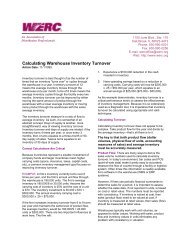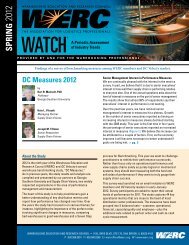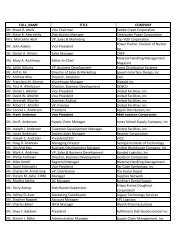Optimizing Inventory Management - WERC
Optimizing Inventory Management - WERC
Optimizing Inventory Management - WERC
You also want an ePaper? Increase the reach of your titles
YUMPU automatically turns print PDFs into web optimized ePapers that Google loves.
processes<br />
Reading Between the Lines<br />
Reading Between the Lines<br />
Numbers can be deceiving in this year’s State of Logistics report.<br />
There was a time, not so long ago, when a steep<br />
drop in the total logistics costs would have been<br />
hailed as great news. So while it would seem that the<br />
18.2 percent drop in U.S. business logistics in 2009—the<br />
largest since the State of Logistics report began—would<br />
be good news, it’s quite the opposite.<br />
The report, sponsored by CSCMP and Penske<br />
Logistics, is in its 21st year. Logistics costs fell to $1.1<br />
trillion, a decrease of $244 billion from 2008. When you<br />
combine that with the drop in 2008, total logistics costs<br />
have declined almost $300 billion during the recession.<br />
Another key indicator, logistics costs measured as a<br />
percentage of U.S. gross domestic product (GDP), also<br />
took a plunge. From 2008 to 2009, those costs dropped<br />
to 7.7 percent, another low not<br />
seen in all the years the report<br />
has been in existence.<br />
So why, with all the new<br />
lows, is this news not good<br />
news? Because the numbers<br />
indicate another trend beyond<br />
lowered cost: lowered business.<br />
The recession forced companies<br />
to slash expenses and demand<br />
for logistics services went down drastically. Shipment<br />
levels declined and freight rates plunged. So while<br />
logistics companies may have found they didn’t have to<br />
spend as much, they most definitely weren’t taking in as<br />
much either.<br />
Rosalyn Wilson, a transportation consultant for<br />
Delcan Corporation, continued this year as the report’s<br />
author. “The recession, which began in December of<br />
2007 and continued through more than half of 2009, had<br />
a negative impact on all segments of the logistics<br />
system,” she reported. “The logistics industry felt the negative<br />
effects of the recession more than most other<br />
industries because the downturn in each individual<br />
sector translated into a loss in shipment volume.<br />
“In mid-2008, bloated inventories began to be drawn<br />
down until they reached pre-recession levels in late 2009.<br />
Throughout the period, orders for new goods dropped<br />
off substantially and carriers competed for a dwindling<br />
…the numbers<br />
indicate another trend<br />
beyond lowered cost:<br />
lowered business.<br />
volume of shipments. Spot rates for some modes fell<br />
below costs, further adding to the financial decline.”<br />
Breaking it down<br />
Taking a closer look at the numbers, it’s apparent<br />
that just about every sector of logistics costs went down.<br />
Transportation costs, for instance, dropped 20.2 percent.<br />
Trucking, which is the largest component of the transportation<br />
sector, has been one of the hardest hit modes<br />
in the recession. It dropped 20.3 percent in 2009 and on<br />
a volume basis, truck tonnage was down 8.7 percent over<br />
already depressed levels in 2008. Truckload capacity<br />
continues to drop, according to the report.<br />
As far as warehousing goes, the cost fell 2 percent in<br />
2009. “Warehouses were still full in early 2009 because<br />
retailers could not move their goods,” said Wilson. “By<br />
midyear, inventories had been liquidated or consolidated,<br />
freeing up warehouse space. Vacancy rates rose as<br />
inventories fell in 2009.”<br />
<strong>Inventory</strong> carrying costs declined 14.1 percent in<br />
2009 and now account for 2.5 percent of nominal GDP.<br />
The drop in interest rates contributed to this fall, along<br />
with the overall drop in inventory levels.<br />
The cost of rail transportation was down 20.6 percent<br />
in 2009. Wilson reported that the Association of<br />
American Railroads estimated that the industry now<br />
has approximately $43 billion in idle assets. “The big<br />
difference between the loss of capacity in the trucking<br />
sector and the loss in the rail sector is that the rail equipment<br />
has been merely sidelined and is readily available<br />
to return to service when demand rises,” said Wilson.<br />
Positive outlook<br />
While 2009 did not bring good news, Wilson says<br />
that there is reason for optimism. “The best thing we can<br />
say for 2009 is that it is good that it is behind us,” she said.<br />
“Let’s look to the future, which is improving as each<br />
month passes.”<br />
Wilson said that the first half of 2010 provided strong<br />
signs that the economy is recovering, and that most<br />
economists believe the United States has passed the<br />
10<br />
/ September–October 2010







